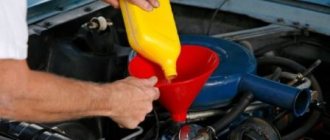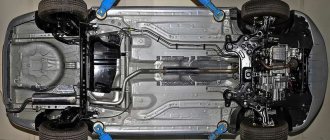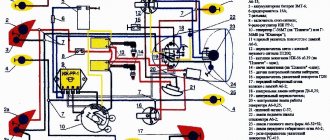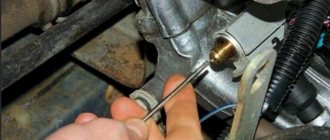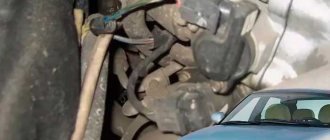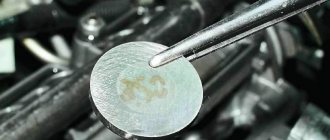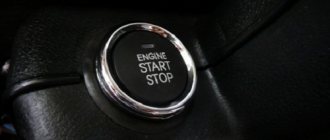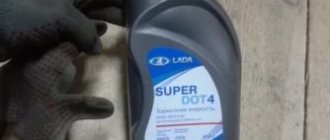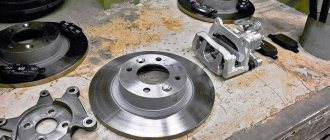How to check the fuel fluid level?
By looking under the hood, where a special tank is located, you can check the level. The tank is made of translucent plastic, so it is easy to determine by the minimum and maximum value marks whether the brake fluid has left or remains in the original amount. In case of topping up, it is better to familiarize yourself with the car's instructions in detail: in some brands that have ABS, bleeding of the brakes is required.
If you do lose brake fluid, you should first understand the reasons. Under no circumstances should you continue driving.
Mono: how to change car brake fluid for one person without assistance
There is only one way to solve the question of how to replace brake fluid for one person. His goal is to update the composition in the tank and lines without using the help of a partner. The features of this method are similar to bleeding the brakes:
- To speed up the process, it is recommended to immediately remove the working emulsion from the expansion tank using a bulb or a syringe with a tube attached.
- The preparatory stage consists of purchasing 1 liter of brake fluid and a 1 meter long tube, suitable in diameter to the outlet fittings on the brake cylinders. You will also need a cut-off bottle with a certain amount of working fluid so that air does not pass through the fitting into the system.
- During the process of replacement/pumping, the composition gradually leaves the tank. The level must be replenished regularly, otherwise the system will become airy.
Process technology
The essence of the replacement is the flow of the working fluid under the influence of gravity. After all, the tank is at the highest point. In fact, the operation is no more difficult than checking the injectors of a diesel or gasoline engine. As a result, the set of actions is as follows:
- Empty the expansion tank and fill it with new fluid up to the MAX limit mark.
- Clean all 4 drain fittings and install tubes on them. Place the latter in plastic containers with “brake fluid”.
- Unscrew all the drain fitting nuts one by one:
- right rear;
- left rear;
- right front;
- left front.
- While watching how the composition drains, do not forget to add a new drug to the tank.
- When the volume of liquid poured from the left front wheel reaches approximately 200 ml, tighten the fittings on it and on all other cylinders in the reverse order:
The tank is cracked - what to do first?
Some motorists mistakenly begin to dismantle the entire brake assembly. Calmness and a visual inspection are the first step towards a successful repair. Wet marks and smudges indicate a decrease in the level of the substance. If a crack is detected, experienced car owners advise replacing the tank immediately - sealing it will not help. What to do if an incident happens on the route?
First aid when a crack is detected
The reasons why brake fluid leaves the reservoir can be different. This may occur as a result of the machine hitting an obstacle. The car service is far away - what should I do? Repairing a crack in the path is only possible to continue moving. Upon arrival at your destination, you will have to purchase a new tank. Glue doesn't help in most cases. Craftsmen recommend using a regular 40-watt soldering iron, slightly extending the rod and slightly loosening the top screw. A piece of plastic tape similar to the body of the tank is cut off. It is unsoldered and used as a patch. First you need to go over the crack with a soldering iron, then use a strip of prepared plastic.
Replacing the tank on a VAZ-2109
The algorithm for replacing the tank is simple. The car must be washed outside and in the engine compartment. This should be done manually, avoiding moisture getting on the pads, starter, and sensors.
Then you need to jack up the car and clean the threaded connections that you will have to deal with. By visual inspection, you can recognize where the brake fluid goes. The reasons for this trouble will also in most cases become clear.
By unscrewing the nuts and disconnecting the cover wires, a person gains access to the tank, which must be removed.
Important advice from experienced car owners! To loosen hose clamps, it is better to unscrew the bolts using pliers.
Topping up brake fluid: do's and don'ts
The general automotive rule, top up what you put in, is relevant for all technical fluids, including brake fluids. If you don’t remember the brand of the compound you poured, and you don’t have any maintenance records with you, welcome to the world of Department of Transportation standards.
According to DOT regulations, brake fluids are classified by boiling point and viscosity. The requirements are important - the brake fluid must not boil: when the brakes heat up excessively, gas bubbles form. They compress and the pedal falls, leading to system failure. Viscosity is also clear: brakes must be equally effective in cold and hot weather.
So, there are four types of brake fluids:
- DOT 3 – low-speed equipment.
- DOT 4 – civil small cars with disc and drum brakes.
- DOT 5.1 – sports and civilian modifications with “discs” in a circle.
- DOT 5 – racing cars.
A numerical explanation of the differences between these four products is provided by FMVSS No. 116, an excerpt from which is given in the table. To understand what can be mixed with what, you need to understand the differences in chemical composition.
The structure of brake fluid is similar to motor oil - it is a base, which can be mineral, glycol, silicone, + additives, additives, dyes. The conversation about what kind of engine oil to use for topping up came up the day before. The conclusion was this: if you mix products from different manufacturers with each other, then only if the base and viscosity indicators are 100% similar. The same analogy can be drawn with the braking system. But first, let’s look at the chemical composition of each DOT:
- BSC – mineral base (castor oil and alcohol in a 1:1 ratio).
- DOT 3,4,5.1 – glycol base (chemical compound based on polyhydric alcohols).
- DOT 5 – silicone base (silicon-organic polymer products).
Considering that the vast majority of cars use glycol brake fluids, it is good practice to have a sealed bottle of DOT 4 or DOT 5.1 with you. Why sealed? The fact is that already in the open state, the technical fluid absorbs moisture from the atmosphere, which is why after a year it becomes unsuitable for use.
If you are a fan of retro technology, then keep in mind that you cannot add glycol to mineral liquid. However, it is also prohibited to fill the empty brake lines of an old car with glycol fluid: the cuffs will swell, and clots will form from the remains of the “mineral water”.
Clutch hose repair method
Experts say one of the common reasons why clutch brake fluid has leaked is a damaged hose through which fluid circulates from the reservoir to the clutch.
Effective replacement tips:
- You need to remove the tank itself by removing the clamp from below.
- You should purchase a new hose, preferably red.
- You need to pull out the damaged hose carefully so as not to accidentally break off the plastic fitting.
It is important not to allow fluid to leak onto the fender or paint. After removing the tank, you should rinse it with water; it is also recommended to replace the clamps. We install the hose and tighten it without much effort. Don't forget to tighten the nuts as well.
Experts say that the hose often wears out. It must be checked periodically and, if damage is detected, replaced with a new one.
Brake cylinder leak
A common cause of brake fluid loss is a leaking cylinder. The occurrence of a problem is judged by the stain left under the vehicle. Finding out the reason is easy.
- You will have to remove the wheel and carefully inspect the brake disc.
- The calipers should be checked for leaks.
If you have a brake drum system, there is an urgent need to remove the drums. The problem involves wear of the rubber seals. Especially often, such troubles await residents of regions with severe frosts.
How to fix brake fluid leaks
Eliminating brake fluid leaks is not a difficult task, and you can easily do it yourself. To do this, you will need the tools that are included in the regular machine maintenance kit. First of all, you need to inspect the hoses. If kinks, cracks, or other damage, even minor, are detected, the hoses should be changed.
In passenger cars, hoses are usually interchangeable and standard, but it also happens that suitable hoses are not easy to find. If you find that the leak is somewhere in one place, for example, brake fluid is leaking on the rear wheel, you will have to change the seal. The entire operation will take a few minutes. The car will first need to be lifted with a jack, and boards or wooden blocks placed under the axle. After this, the wheel is removed. Do not forget to wedge the remaining wheels or put the car on the handbrake.
Then you will need to remove the caliper, having first locked the brake pedal depressed. To do this, it is convenient to use a small piece of board. Then move the piston and the caliper can be removed. If it sits tightly and does not give way, then press the brake pedal several times, this will push the piston out of the cylinder. After which removing the caliper will not be difficult. Now you can proceed directly to the repair.
The seal socket needs to be thoroughly cleaned, freeing it of any stuck pieces of old material. Inspect the cylinder for corrosion. If corrosion areas are found, the entire surface will need to be sanded with fine-grain sandpaper. Check whether the valve on the bleeder fitting unscrews (there should be no problems with this). Then a new seal is installed. Replace the boot; it will prevent dust from entering the piston.
If you periodically inspect the car's systems, detect brake fluid leaks in a timely manner and eliminate minor defects, this will allow you to maintain the brake system in order.
We recommend
“Checking the hand brake: signs of malfunction and their elimination” Read more
About the consequences
There can be many answers to the question of where the brake fluid goes from the reservoir. It can go into the vacuum muffler. This indicates a high percentage of wear on the master cylinder piston cuff. For simple rubber there is nothing terrible about this. Another issue is the accumulation of the product in the form of a dangling layer. This will result in an increase in resistance at high diaphragm speeds. There is an opinion that such a situation simply kills the diaphragm. By changing the cuff, movement will become safe. Sometimes you have to install a repair kit while disassembling the vacuum unit.
Some motorists ask whether brake fluid can leak into the engine. Experts give a negative answer. She can only get there if she confuses the canisters with liquid.
The brake fluid suddenly went away. Verdict – it’s flowing, but where?
Any hydraulic system with moving parts includes rubber seals, and the brake system is no exception. Cuffs allow you to dock various parts, mate moving parts with stationary ones, without giving liquid any chance of leaking. At the same time, the cuffs are the weak link of any unit. It becomes even weaker from low-quality brake fluid, long-term parking and low-quality materials used in its production.
However, there are also unusual situations when the brake line cracks or defects are found in the master brake cylinder. Returning to the standard places of leaks, it should be noted that it is worth looking at all the places where rubber seals are used and the diagram will help us with this:
- Vacuum brake booster (VUT) – master cylinder (GTC).
- The reservoir is the main brake cylinder.
- Each of the cylinder-piston wheel pairs.
Another location of the leak can be determined by the pattern of movement of the brake pedal:
- Soft, goes to the floor - wheel calipers.
- Hard – leaks in the area of the brake master cylinder or reservoir.
Statistics show that leaks are most often observed in the area where the GTZ is attached to the CWF. The layout of the engine compartment often does not allow easy inspection of this unit. However, external examination does not always give results. The insidiousness of this place is that the internal seal of the GTZ rod can weaken, causing the liquid to go inside the VUT, and everything outside is dry. In this regard, take note of a couple of recommendations:
- The inside of the vacuum booster must be dry. Run a rope through the hole connecting the vacuum reservoir to the intake manifold - it should be dry.
- There should be no foreign odors inside the VUT. Through the same hole, check for a brake smell.
When it flows in the area of the wheels, the drips are clearly visible from the inside of the casing located on the hub.
Symptoms of defects in the master brake cylinder
Rubber seals on the brake master cylinder cause leaks. They cause penetration of the vacuum booster. In such a situation, replacing the cylinder will help. If a malfunction occurs with the cylinder, the brakes fail completely or do not work correctly. The main challenge for this part is the aging of the brake pads. Diagnostics involves an initial warning to the driver using indicators on the dashboard and checking the pressure in the system. What does the motorist see as a result of the problems that have arisen?
- Pressing the pedal, the owner of the steel horse feels its slow stop. The point here is the loss of tightness of the pistons or wear of the cuffs.
- A short pedal stroke means a high concentration of brake fluid; it has nowhere to go due to a clogged hole or a swollen rubber seal.
- There is a failure of the pedal: the matter is in the liquid rushing into the expansion tank.
How to get to a service station if brake fluid leaks on the road
If you notice that the brake pedal is sinking, this indicates a brake fluid leak. In this case, the corresponding indicator signals an emergency situation. If you see such a red icon on the dashboard, you need to take immediate action, otherwise the trip may end in an accident.
If you see a red brake light while driving, you should stop immediately. Look into the reservoir with the brake fluid, if you see that its level has dropped below the minimum, you have found leaks of brake fluid, it must be topped up. If you do not carry suitable solutions with you, you will have to drive to the store. It is possible that over the next year or longer the warning light will no longer bother you.
But if after a few days or even weeks the indicator again begins to signal a malfunction of the brake system, and you again observe leaks of brake fluid, then the matter will no longer be limited to just topping up. The reason may be wear on the caliper cylinder pads; brake fluid leaks through these places. You may find brake fluid leaks under the clutch cylinder, which means this is a problematic system that needs to be inspected and repaired.
If you find that the level of fuel fluid in the reservoir is rapidly falling, and no brake fluid leaks are visible, it means that the brake booster has broken down - a defect has formed in the membrane, through which liquid is leaking into the large container. The system will have to be repaired at a car service center. Call the technician and find out what parts are needed. Then you will need to place an order for parts and schedule a repair date.
It happens that during the next inspection, brake fluid leaks are discovered on the rear wheel. What to do in this case?
A leak on the inside of the wheel indicates that the brake cylinder seal has torn. The caliper may also come out of the cylinder or the pads may wear out badly, and this also leads to intense leakage of brake fluid. If the tank turns out to be empty, in order to get to the repair shop, you need to pour at least some liquid into it. This could be vodka; it is preferable to water in winter because it will not freeze. You can also pour oil, it will not boil under pressure. In extreme cases, you can pour water. If you urgently need to repair your car, then there is no choice.
For example, you diluted soap in water and poured this mixture into the tank to the top, but when you press the brake pedal, the solution suddenly begins to flow away. A few presses on the pedal will completely empty the barrel, and there will be brake fluid leaks under the car.
How to be in this case? There is only one way out - call a tow truck. The brake system of your car does not work at all; you cannot drive such a car. Such a vehicle cannot be towed. But what if you are, for example, in a deep forest or on a deserted highway, and you can’t reach a tow truck?
In this case, you can proceed as follows:
- fill the empty tank as completely as possible;
- jack up the wheel on which the cylinder is faulty and brake fluid leaks are detected;
- remove the wheel;
- find a piece of rubber from a tube, an old tire protector will do (you can look along the road or in a landfill). As a last resort, you can use a knife to cut off a small piece of the wheel tread;
- unscrew the brake pipe;
- Place a cut piece of rubber on the place where it is attached, blocking the hole;
- put the tube in place.
Secrets of bleeding brakes
To complete the repair process, the brake system needs to be bled. You can do the work yourself or contact the service.
- Fill the reservoir with brake fluid up to the max mark.
- The wheel brake fittings need cleaning.
- Take a separate container and a hose attached to the fitting.
The assistant sitting behind the wheel must press the gas pedal evenly and firmly three times. When pressing the fourth time, the pedal does not need to be released. At this time, you need to unscrew the fitting and look at the outlet of the fuel injection fluid. Bubbles in the stream will indicate air in the system. After the air is released, the fitting is wrapped, and the process is repeated on another set of wheels. Observing all pumping rules, it is impossible to be completely sure of the reliability of the result. Experienced car enthusiasts recommend not to neglect the services of service stations.
When making repairs yourself, experts advise tilting the car slightly towards the wheel in question. The air will rise upward and reach the threaded valve sooner. Lightly tapping the caliper optimizes the process. In addition to the above-mentioned bleeding technique, there is a technique for adding brake fluid to the supply reservoir. This is difficult to do and only experienced vehicle owners can do it. This procedure is not feasible for machines with return pressure control valves.
If handled incorrectly, there is a high risk of causing new breakdowns and having the opposite effect - the appearance of air in the brake system in even larger quantities. Professionals will come to the rescue; they will complete the work competently within the optimal time frame.
Brake fluid leaks: when is this considered normal?
Normally, the fluid level in the reservoir above the master cylinder should drop very slowly and be restored to its previous value after replacing the pads.
In total, if we neglect the hygroscopic tendencies of the overwhelming number of “brakes”, then the volume of technical fluid (working fluid) in the system should not change. A temporary decrease in brake fluid level is associated with pad wear. To be precise, the brake pistons in the calipers and cylinders move out as the friction material wears, increasing the volume of the entire system. Since no one has added brake fluid, its level in the reservoir drops accordingly, while the amount remains the same. In total, a constant gap between the pad and the disc/drum maintains the sharpness of the brakes as the pads wear, and the level usually fluctuates within the permissible gap - between the MIN and MAX marks.
Before installing new pads, it is customary to press in the pistons in the calipers. Similar work must be done with the drum brake cylinders. And now, with regard to the brake fluid level, we see a completely opposite picture: it is rising and this is absolutely normal. So it turns out that there is no need to add fluid to a working system, provided that its level is above the minimum.
